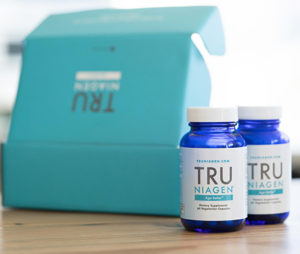This is a “sponsored post.” ChromaDex compensated FOF with an advertising sponsorship to write it. Regardless, we only recommend products or services that we believe will be helpful for our readers. All insights and expressed opinions are our own. —Geri Brin
 No matter where I might be during the day—supermarket to nail salon—I see “older” people who dishearten me. Many of them are 70 years old max. But, these people actually act old! They’re hunched over and walking unsteadily. Their minds don’t seem focused. It looks as if they’ve been drained of all their energy. They sadden me because they’re letting their cells make them act—and look—older than they are.
No matter where I might be during the day—supermarket to nail salon—I see “older” people who dishearten me. Many of them are 70 years old max. But, these people actually act old! They’re hunched over and walking unsteadily. Their minds don’t seem focused. It looks as if they’ve been drained of all their energy. They sadden me because they’re letting their cells make them act—and look—older than they are.
I promise I’m not saying something loony! I’ve learned time and again during the last year, from brilliant scientists I’ve interviewed, that acting old has lots to do with what’s happening within our cells. I’m no scientist (I struggled through biology and chemistry in school), but I’ve made it my business to fathom how our cells keep us healthy and fit in our youth; what naturally happens to us as our cells age, and what we can do to help make them act more like they did decades ago. That way, we can stay fit and healthy for as long as possible.
WHAT’S A CELL, ANYWAY?
Our bodies are comprised of trillions of cells (microscopic organisms), divided into over 200 types, that perform different tasks. Similar cells that do the same job come together in layers to form body tissue, such as muscle, skin, or bone tissue. Groups of different types of tissues make up the organs in our bodies, such as our hearts, livers, or lungs. Each organ has its own job to accomplish, but all organs work together to maintain our bodies.
Each cell has an outer layer, called a membrane, that holds it together and let nutrients pass in and waste products pass out. And, every cell has a “control center,” called a nucleus, which contains the information that allows cells to divide and make more cells. The mitochondrion inside each cell are like little batteries where food and oxygen combine to produce energy.
We grow from infant to child, adolescent, adult and, finally, older adult because new cells are forming all the time. Some cells are lost through wear and tear or injury; others simply reach the end of their life, and others naturally self-destruct. The life cycle of every cell is carefully controlled, so you should always have just the right number of each type of cell.
>> Click here to support your cellular health today.
WHAT HAPPENS TO US AS OUR CELLS AGE?
All cells change with aging. Some might start to function abnormally, while others might lose their ability to function at all. Connective tissues can become stiffer, which make the organs, blood vessels, and airways more rigid. Tissues lose mass, such as heart and brain tissue. Bones become thinner. Cell membranes change, so many tissues have more trouble getting oxygen and nutrients and removing wastes such as carbon dioxide. Cell and tissue changes also can cause our organs to slowly lose function.
Aging is a complex process that affects different people and different organs in different ways. Each of us also ages at a unique rate. Most gerontologists feel that lifelong influences that contribute to aging include environment, culture, diet, exercise and leisure, past illnesses, and many other factors.
>> An anti-aging pill—for real.
INVEST IN YOUR CELLULAR HEALTH TODAY
 Scientists have learned a critical fact about aging, that it appreciably reduces the level of the most important molecule in every single cell of our bodies, called nicotinamide adenine dinucleotide (NAD). We all absolutely need NAD, they discovered, because it allows our cells to convert the fats, proteins and carbohydrates we eat into the energy we need to stay in top shape. It also helps activate longevity genes, which control cellular aging, as well as all those chemical and biological processes that help us stay fit and healthy.
Scientists have learned a critical fact about aging, that it appreciably reduces the level of the most important molecule in every single cell of our bodies, called nicotinamide adenine dinucleotide (NAD). We all absolutely need NAD, they discovered, because it allows our cells to convert the fats, proteins and carbohydrates we eat into the energy we need to stay in top shape. It also helps activate longevity genes, which control cellular aging, as well as all those chemical and biological processes that help us stay fit and healthy.
Even if we do cardio and weight-bearing exercises all week, consume a diet of nutritious whole foods, get adequate sleep, and stay away from smoking and drinking, the unavoidable stresses of life will deplete our NAD levels. But now a brilliant scientist has discovered that nicotinamide riboside (NR), a cutting-edge form of vitamin B3 found in trace amounts in milk, helps our cells replenish their NAD and may actually rejuvenate energy production in the cells. So, it makes complete sense that taking a supplement with NR will give our bodies a proven source of NAD.
I might not be able to look like I did years ago, but I’d be delighted to bring back the vitality I had when I was younger!
 Dr. Charles Brenner, the Stanford-educated PhD who discovered the connection between NR and NAD, is the Chief Scientific Advisor behind TRU NIAGEN™ from ChromaDex, the worldwide patent-holder and innovator behind the ingredient. When the scientific community first looked at Dr. Brenner’s research, it was excited to see that he had discovered something which research suggests has the potential to help us maintain muscle mass and function, as well as heart, nerve and cognitive function as we age.
Dr. Charles Brenner, the Stanford-educated PhD who discovered the connection between NR and NAD, is the Chief Scientific Advisor behind TRU NIAGEN™ from ChromaDex, the worldwide patent-holder and innovator behind the ingredient. When the scientific community first looked at Dr. Brenner’s research, it was excited to see that he had discovered something which research suggests has the potential to help us maintain muscle mass and function, as well as heart, nerve and cognitive function as we age.
I have been taking TRU NIAGEN™ every single morning for the past 18 months, and I feel wonderful— from overall feelings of well-being and mental clarity to improved sleep quality and consistent energy. I can think of only a single time I’ve napped, too. A single dose of TRU NIAGEN™ produces clinically significant increases in NAD levels, supporting our desires to age the best we can!
to start TRU NIAGEN™ today.

